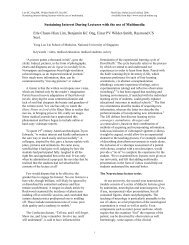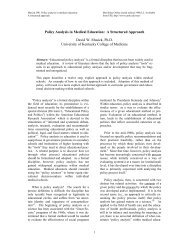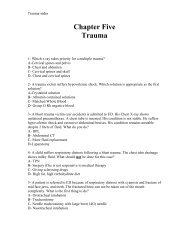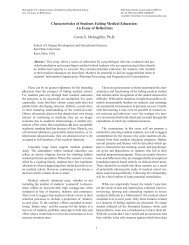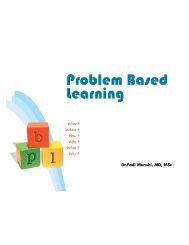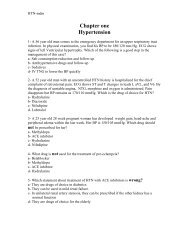Chapter two S3 &S4 gallop* - Medical Education Online
Chapter two S3 &S4 gallop* - Medical Education Online
Chapter two S3 &S4 gallop* - Medical Education Online
You also want an ePaper? Increase the reach of your titles
YUMPU automatically turns print PDFs into web optimized ePapers that Google loves.
<strong>S3</strong>&<strong>S4</strong>-mdm<br />
<strong>Chapter</strong> <strong>two</strong><br />
<strong>S3</strong> &<strong>S4</strong> <strong>gallop*</strong><br />
1-A 65year old man is hospitalized in CCU with the diagnosis of MI. The second day of<br />
his stay in CCU he develops dyspnea.<br />
HR=100 bpm<br />
BP=125/70 mmHg<br />
JVP= raised<br />
S1 and S2 are attenuated and an <strong>S3</strong> is heard in the apex of the heart.<br />
Rales are heard in auscultations.<br />
Which prescription is the least effective?<br />
a- Morphine<br />
b- NTG<br />
c- Digoxin<br />
d- Dobutamine<br />
2- A 55 year old woman comes to ED with exertional dyspnea, a raised JVP and<br />
prominent X and Y waves. Kussmaul sign is positive. S1 and S2 plus another high<br />
pitched extra sound can be heard on the apex. Pulsus Paradox is not detected. Which is<br />
the best diagnosis?<br />
a- Tamponade<br />
b- Constrictive pericarditis<br />
c- Restrictive cardiomyopathy<br />
d- Right ventricle infarct<br />
________________________________________________________________________<br />
* Sounds generated by rapid ventricular filling are often called “gallop rhythms” or third/fourth heart sound; <strong>S3</strong> and<br />
<strong>S4</strong>. Both sounds are of low frequency, <strong>S3</strong> occurring in early diastole, <strong>S4</strong> in late diastole. <strong>S3</strong> can occur in healthy<br />
children and young adults and is then not considered pathological. In patients above the age of 40 the presence of <strong>S3</strong> is<br />
recognized as an early indicator of heart disease. <strong>S4</strong> is not a common finding in the young and healthy and is<br />
considered a sign of heart disease.<br />
Gallop rhythms are signs of early stage heart failure. <strong>S4</strong> is less specific than <strong>S3</strong> and can often be confused with a<br />
split first heart sound or first heart sound followed by an opening snap. <strong>S3</strong> is considered one of the best predictors of<br />
early heart disease.<br />
<strong>S3</strong> can be confused with the opening snap of mitral valve in mitral stenosis. The opening snap is higher in pitch and is<br />
usually occurring earlier in diastole.<br />
<strong>S4</strong> can be confused with a split S1 or a S1 followed by an ejection sound. <strong>S4</strong> is of lower pitch than the other sounds,<br />
and an established timing by EKG or by palpation should be enough to distinguish these sounds.<br />
In the middle aged and older age, the third heart sound is usually a sign of increased thickness in the ventricular<br />
wall.<br />
In mitral regurgitation, the subsequent increased flow into the ventricle will contribute to an audible <strong>S3</strong>.<br />
In constrictive pericarditis, the <strong>S3</strong> is called a pericardial knock, as it occurs slightly earlier and is of higher pitch.<br />
The fourth heart sound is usually seen in context with significant aortic stenosis, Dialted and Hypertrophic<br />
Cardiomyophaty (HCM), systemic hypertension and in coronary artery diseases. .
<strong>S3</strong>&<strong>S4</strong>-mdm<br />
3- What sign is the least prevalent for constrictive pericarditis?<br />
a- Kussmaul sign<br />
b- prominent Y wave<br />
c- prominent X wave<br />
4- pulsus paradox<br />
4- A 60 year old man with a history of chest pain on exertion has a BP of 140/90mmHg<br />
and a heart rate of 85. He has a positive stress test and an ejection fraction of 40% in<br />
echocardigraphy. What combination is good for his BP?<br />
a- betablocker+isosorbide<br />
b- betablocker+diltiazem<br />
c- betablocker+verapamil<br />
d- isosorbide+nifedipine<br />
5- What is among the signs of Temponade?<br />
a- Kussmaul<br />
b- prominent X<br />
c- pericardial knock<br />
d- 4 th heart sound<br />
6: For what type of heart failure Carvodilol is a betablocker of choice?<br />
a- Class IV heart failure<br />
b- Failure with a normal Ejection Fraction<br />
c- Previous pulmonary edema stable at present<br />
d- Within a short interval of MI<br />
7- All of the following can be used for cases of pulmonary edema with systolic left<br />
ventricular dysfunction except:<br />
a- IV Digoxin<br />
b- Loop diuretic is the diuretic of choice<br />
c- Aminophillyne to enhance heart contractility<br />
d- ACE inhibitors to lower afterload<br />
8- A 50 year old man has the chief complaint of dyspnea and exertional chest pain.<br />
BP=160/100 mmHg / PR=90 bpm<br />
Heart rhythm= irregular<br />
JVP= raised<br />
Pitting edema =2+<br />
Rales are present. Liver is palpable and tender. No pericardial effusion is detected. No<br />
stenosis or regurgitations of valves can be detected. What should not be prescribed for<br />
this case?<br />
a- Digoxin<br />
b- Nitrates<br />
c- Betablockers<br />
d- Diuretic
<strong>S3</strong>&<strong>S4</strong>-mdm<br />
<strong>S3</strong> & <strong>S4</strong><br />
Diastolic Dysfunction Systolic<br />
Examine JVP<br />
Not raised Raised<br />
HCMP Check for Pulsus Paradox<br />
Negative=<br />
Constrictive pericarditis<br />
Positive= check for Kussmaul<br />
sign<br />
Positive= RCMP Negative= Tamponade<br />
Algorithm 2-1: Differential Diagnosis of <strong>S3</strong> and <strong>S4</strong>.<br />
(DCMP=Dilated cardiomyopathy/ JVP= Jugular vein pressure/<br />
HCMP=Hypertrophic cardiomyopathy/ RCMP=Restrictive cardiomyopathy)
<strong>S3</strong>&<strong>S4</strong>-mdm<br />
ED observation or<br />
short stay<br />
Assess BP,<br />
volume<br />
Status and<br />
perfusion<br />
Algorithm 2-2: Acute Pulmonary Edema Management<br />
Consider<br />
consultation<br />
and referral<br />
ED<br />
observation or<br />
short stay
<strong>S3</strong>&<strong>S4</strong>-mdm<br />
Different causes of <strong>S3</strong> & <strong>S4</strong> gallop Treatment<br />
HCMP Defibrillator<br />
Amiodarone for AF rhythm<br />
Endocarditis prophylaxis<br />
Anticoagulant<br />
Constrictive Pericarditis Salt restriction<br />
Diuretic<br />
pericardiotomy<br />
RCMP Anticoagulant<br />
Diuretic<br />
Tamponade Thoracotomy (in an ordinary tamponade<br />
NS or Blood or vasopressor may be<br />
indicated)<br />
Acute pulmonary edema Furosemide IV 0.5 to 1 mg/kg<br />
Morphine IV 2 to 4 mg<br />
NTG SL<br />
Oxygen/intubation as needed<br />
Low output cardiogenic shock SBP100<br />
NTG=10-20 mcg/min IV<br />
Consider SNP: 0.1-5 mcg/kg/min IV<br />
ACEinh. if SBP is not
<strong>S3</strong>&<strong>S4</strong>-mdm<br />
Drugs of importance:<br />
drug contraindications dosage explanation price<br />
SNP<br />
Hypersensitivity<br />
Reduced cerebral -<br />
perfusion<br />
AVF<br />
Coarctation of aorta<br />
(2cc/50 mg)<br />
0.3-0.5<br />
mcg/kg/min<br />
It should be<br />
diluted in 250-<br />
1000 cc DW5% or<br />
NS. It should be<br />
50100 Rls.<br />
AF or flutter with rapid<br />
ventricular rate<br />
covered to light by<br />
aluminum foils.<br />
TNG<br />
Dopamine*<br />
Dobutamine<br />
Norepinephrine<br />
Frusemide<br />
Warfarin<br />
Carvolilol<br />
Hypersensitivity<br />
Low blood pressure<br />
Anemia<br />
Shock<br />
Head trauma<br />
Closed Angle Glucoma<br />
Cerebral hemorrhage<br />
Hypersensitivity<br />
Pheochromocytoma<br />
VF<br />
OHCM<br />
Hypersensitivity<br />
IHSS<br />
AF<br />
flutter<br />
Hypersensitivity<br />
OHCM<br />
Vascular thrombosis<br />
Hypersensitivity<br />
Hepatic coma<br />
Anuria<br />
Electrolyte depletion<br />
Hypersensitivity<br />
Bleeding<br />
Peptic ulcer<br />
Open wound<br />
Liver and kidney-<br />
disease<br />
Hypersensitivity<br />
Cardiogenic shock<br />
Pulmonary edema<br />
Bradycardia<br />
AV block<br />
Uncompensated -<br />
HF<br />
Digoxin Hypersensitivity<br />
IHSS<br />
Beriberi<br />
Diastolic heartdysfunction<br />
Carotid sinussyndrome<br />
(1cc/5mg)<br />
0.2-10<br />
mcg/kg/min<br />
(Amp 200mg/5cc)<br />
5 mcg/min/kg IV<br />
(Vial 250 mg)<br />
0.5 mcg/min/kg IV<br />
(Vial 10mg)<br />
0.5-1 mcg/min<br />
IV inf.<br />
(Amp 20 mg)<br />
20-80 mg/day<br />
(Tab 5mg)<br />
5 mg/d<br />
(Tab 6.25 mg)<br />
3.125-0.375 mg po<br />
qd<br />
(Tab 0.25 mg)<br />
0.125-0.375 mg po<br />
qd<br />
It should be<br />
diluted in 50cc<br />
DW5% or NS.<br />
Not to exceed 20<br />
mcg/kg/min<br />
(See dopamine<br />
chart in table2-3)<br />
Titrate to desired<br />
effect<br />
Titrate not to<br />
exceed 30<br />
mcg/min<br />
Titrate up to 600<br />
mg/d for severe<br />
edema<br />
for 2-4 days<br />
subsequent doses<br />
determined by INR<br />
4765 Rls.<br />
2000 Rls<br />
6500 Rls<br />
33890 Rls.<br />
800 Rls<br />
370 Rls<br />
220 Rls<br />
236 Rls<br />
Table2-2: Drugs mentioned in this chapter. (An important note to remember: qd means per day and<br />
qid means 4 times a day.)
<strong>S3</strong>&<strong>S4</strong>-mdm<br />
Answers:<br />
1-c<br />
2-b<br />
3-d<br />
4-a<br />
5-b<br />
6-c<br />
7-d<br />
8-a<br />
Dopamine Chart (gtts/min)<br />
(400mg/250cc Normal Saline)<br />
KGS 40 50 60 70 80 90 100<br />
MCG/MIN<br />
5 8 10 12 13 15 17 19<br />
10 15 19 22 26 30 33 37<br />
15 22 28 33 39 44 50 56<br />
20 30 37 44 52 59 67 74<br />
25 37 46 56 65 74 82 93<br />
Table2-3: Dopamine Chart<br />
References:<br />
1- auscultation.com/Human/Heart/.../ DiastolicGallopRhythm.htm<br />
2- Braunwald Eugene, et al. Harrison's Principles of Internal Medicine. 16th Edition.<br />
McGrawHill; 2005<br />
3-Institute for clinical systems improvement (ICSI). Diagnosis and treatment of chest<br />
pain and acute coronary syndrome (ACS).Bloomington (MN);2005 oct.77p<br />
4- Iranian Council for Graduate <strong>Medical</strong> <strong>Education</strong>. Exam questions.<br />
5-Katzung Bertram G. Pharmacology: Examination & Board Review.7th edition<br />
Mcgrawhill. 2005<br />
6-www.emedicine.com/med/topic3552.htm.2006
<strong>S3</strong>&<strong>S4</strong>-mdm



